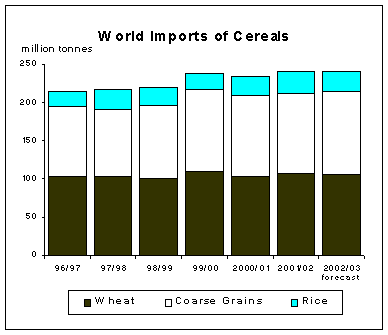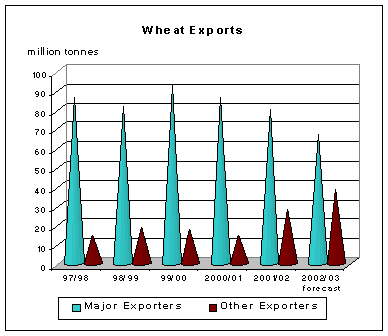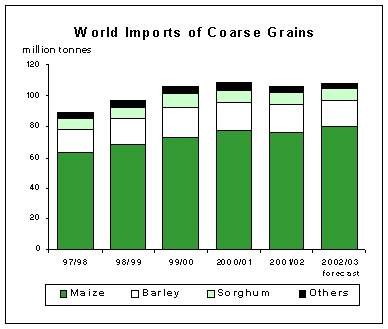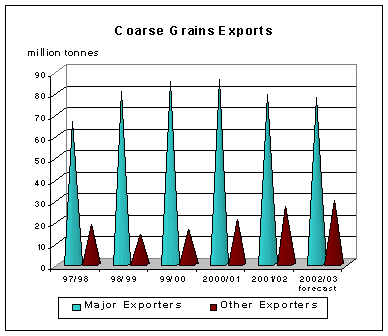


 |
 |
|
 |
||
|
|
||
|
|
|
| food outlook | |
| No. 2 | Rome, April 2003 |
|
Trade 1/
World trade in cereals in 2002/03 is now forecast at 241 million tonnes, up slightly from the previous report but still 2 million tonnes below the estimated level in 2001/02. The anticipated decline from the previous season would be mainly driven by a likely contraction in wheat and rice trade, while trade in coarse grains is forecast to increase.  Global trade in wheat 2/ in 2002/03 is forecast to fall to 106 million tonnes, down 2.6 million tonnes from the previous season. Most of this season’s anticipated decline would be on account of smaller imports by several countries in Asia, where aggregate imports in 2002/03 are forecast at about 44 million tonnes, down 3 million tonnes from the previous season. The largest drop is anticipated in the Islamic Republic of Iran, where, following a bumper crop in 2002, imports are forecast to be reduced by half to 3.3 million tonnes, which would also be smallest volume since 1998/99. Good harvests in many parts of Asia are also expected to limit imports in several countries in that region. By contrast, in Africa, wheat imports are forecast to reach a record level of just over 26 million tonnes, up 1.4 million tonnes from the previous season. Sharply lower outputs in Algeria and Tunisia could result in an increase of almost 1 million tonnes in their combined imports this season. Imports by most countries in the sub-Saharan region are expected to remain unchanged or increase slightly from the previous season, but in Ethiopia imports are forecast to surge by almost 900 000 tonnes to 1.2 million tonnes (mostly in the form of food aid) as a result of poor harvests. Imports in Europe are also forecast to exceed the previous season’s already high level by about 1 million tonnes. Contrary to earlier expectations, EU purchases continued throughout the season and imports are now forecast to approach 11 million tonnes, up 800 000 tonnes from the previous season’s level. At the current forecast level, the EU would be the world’s largest wheat importer for the second consecutive season. Total imports by countries in Latin America and the Caribbean are forecast to remain close to the previous season’s level. Wheat purchases by Mexico are expected to increase slightly due to a small decrease in domestic production, but imports by Brazil, a leading wheat importer, are expected to remain unchanged from the previous year at around 6.8 million tonnes. Overview of World Cereal Imports
Source: FAO 1/ Highly tentative. Turning to wheat exports, total shipments from the five major exporters this season are currently forecast to fall to 67 million tonnes, representing a decline of around 13 million tonnes, or roughly 16 percent, from the already reduced level in the previous season. Only the EU is seen to increase its exports. While shipments by the EU plunged to around 11 million tonnes in 2001/02, a rise in production is likely to boast exports by over 4 million tonnes to around 16 million tonnes. Exports by the United States are forecast to remain at around the previous year’s level, sales from Australia and Canada are forecast to drop sharply as a result of reduced supplies. Wheat exports from Argentina are also forecast to decrease following a drop in its production.  By contrast, wheat exports from most non-traditional exporting countries are likely to exceed last season’s exceptionally high volumes. Shipments from the Russian Federation are now forecast to reach 10 million tonnes, representing more than a two-fold increase from last year. At this level, the Russian Federation would be the world’s third largest wheat exporter - after the United States and the EU. Exports by Ukraine are also forecast to increase sharply to 8 million tonnes, compared to 5.5 million tonnes in the previous season. In addition, Kazakhstan and India are also likely to each export 5 million tonnes this season. Overall, the combined volume of exports from these non-traditional exporting countries would approach 30 million tonnes, representing nearly 28 percent of the global market share this season, up sharply from 15 percent in 2001/02. World trade in coarse grains in 2002/03 is forecast to reach 108 million tonnes, up 1.4 million tonnes from the previous season’s reduced level. The increase from 2001/02 would be driven mainly by higher trade in maize, rye and oats, while trade in most other major coarse grains is expected to decline slightly from the previous season. In the maize market, this season’s exports are likely to exceed the previous year’s record and approach 80 million tonnes, representing nearly three-fourths of the world trade in coarse grains.  The anticipated increase in world trade this season is mainly driven by a sharp increase in imports in Africa. Total coarse grain imports in Africa are expected to rise by 3 million tonnes from the previous season, to a record high of 18 million tonnes. Higher imports by several countries in the sub-Saharan region, following shortages triggered by production shortfalls, are mostly responsible for this surge. The most significant increases are expected in Zimbabwe (up 1.6 million tonnes), Kenya (up 400 000 tonnes) and Zambia (up 255 000 tonnes). By contrast, in Asia, aggregate imports of coarse grains in 2002/03 are forecast at 56 million tonnes, down 1.2 million tonnes from the previous season. Imports by Saudi Arabia and the Islamic Republic of Iran are forecast to fall significantly, whereas, in most other Asian countries, imports are likely to remain at around the same levels as in the previous year. In Europe, total imports could reach 6.7 million tonnes this season, down 700 000 tonnes from the previous year. The main reason for this decrease is larger purchases of cheaper feed wheat by the EU. In North America, the drought in Canada is expected to give rise to much larger imports of maize and barley. In Central America, larger maize purchases are also forecast for Mexico, reflecting a decline in production. In South America, imports by most countries are likely to remain at the same levels as in the previous year. On the export side, among the major exporters, coarse grain shipments from the United States are forecast at 55 million tonnes in 2002/03 (July/June), down 1.5 million tonnes from the previous season, mostly due to reduced production. Smaller exports are also forecast for Canada and Australia given the decline in their supplies as a result of lower production. By contrast, shipments from Argentina could increase slightly, while sales from the EU are forecast to rebound after a sharp decline in the previous season. More barley exports are expected from the EU this season, which could, to some extent, compensate lower global supplies due to shortages in Australia. Apart from major exporters, China continues to export maize, which is currently put at 12 million tonnes for 2002/03, nearly twice as much as in the previous season. In addition, another year of good export prospects is expected for the Russian Federation and Ukraine. 
FAO has raised its estimate of global rice trade in 2002 to an all time high of 28.1 million tonnes, well in excess of the previous record of 27.5 million tonnes achieved in 1998. The new figure reflects higher estimates of exports by several of the major world rice suppliers, including China, India, Pakistan, the United States and Uruguay, while shipments by Thailand and Australia were cut somewhat. On the import side, the revisions were more widespread, with particularly sizeable adjustments made for Bangladesh, the Islamic Republic of Iran, Ghana and the Russian Federation. The large trade expansion in 2002 took place notwithstanding the low imports made by China, which originally had been expected to boost world demand, following the opening of low tariff quotas by the country. Instead, China kept a very low profile as an importer in 2002, while shipments to Indonesia, the Islamic Republic of Iran, the Philippines, Ghana, Nigeria and South Africa surged. The expansion was facilitated by the abundance of supplies made available by exporters, especially India. Indeed, the implementation of new export policies helped the country release about 6.6 million tonnes from public rice inventories onto the world market at very competitive prices, more than three times the level exported in the previous year. Food aid shipments also boosted exports from the Republic of Korea. As Indian rice displaced supplies from Thailand and Viet Nam, both countries faced an overall contraction in sales in 2002. Elsewhere, production shortfalls lay behind a fall in shipments by Australia, Argentina, Pakistan and Uruguay.
FAO forecast of international trade in rice in 2003 remains virtually unchanged from the last report at 26.8 million tonnes but about 5 percent below the revised estimate for 2002. Such a drop would be consistent with the reduced export availabilities in India and Australia and the lower import requirements in a number of traditional importers that harvested good crops last season. Despite a record crop, Bangladesh is anticipated to import 600 000 tonnes this year, against a previous estimate of 300 000 tonnes. The adjustment reflects the recent lowering of import tariffs from 29 percent to 7.5 percent, made in reaction to high domestic prices. Last January, China (mainland) announced that it would allow private enterprises to import up to 2.26 million tonnes of long grain rice and 1.53 million tonnes of short/medium grain rice in 2003 under the 1 percent import quota. Based on the country’s WTO commitments, this would imply that state agencies had reserved themselves the right to import about 1 million tonnes under the quota. Nonetheless, FAO’s forecast for the country’s imports remains much lower, at 250 000 tonnes, which would be little changed from last year. Despite the steady fall in production, domestic rice prices have remained depressed, rendering imports uncompetitive. This situation is not expected to change in the short run, as large supplies from state inventories are likely to be released on the market, keeping downward pressure on prices. Meanwhile, the Hong Kong SAR eliminated the import quota regime that had been in place since 1955 and removed importer entry barriers as of 1 January 2003. Imports by Indonesia, are currently forecast at 3.4 million tonnes in 2003, 200 000 tonnes more than earlier anticipated and only marginally below last year. However, much will depend on the production outcome this season. Despite its pledge towards rice self-sufficiency, the country has failed to achieve its production target of 53 million tonnes in the past three years and has continued to rely extensively on the international market. Nonetheless, a small reduction in shipments is anticipated this year in light of the increase in tariffs from Rupees 430 to Rupees 510 per kilo implemented on 1 January. The Philippines may also import less this year, given expectations of a record 2002 (July/June) crop. Although the country has set an initial 800 000 tonne target for imports, FAO’s forecast volume of 1 million tonnes, is still 200 000 tonnes less than last year. The implementation of a new import system, which puts an end to the monopoly of the National Food Agency, may also slow the flow of rice into the country. Based on the recently amended mechanism, rice farmers will be allowed to apply for rice import licenses, subject to a ceiling of 1 000 tonnes per farmer or farmer organization, per year. Additional requirements include: the opening of letters of credit to cover the deal, the payment of a 50 percent import tariff, and stiff penalties if shipments do not reach the ports within the lean period, not to depress producer prices. Overall shipments to Near East countries are anticipated to fall to 4.8 million tonnes in 2003, down from 5.2 million tonnes in 2002, reflecting expectations of smaller purchases by the Islamic Republic of Iran, following a recovery in 2002 production, and by Iraq. In the latter, war has seriously disrupted normal economic activity with uncertain implications on the country’s ability to import. Similarly, imports to Africa are set to decline to 7.7 million tonnes in 2003, down from 8.2 million tonnes last year. If confirmed, this would be the first contraction since 1993. The reversal of the long term rising trend would be mainly on account of smaller purchases by the two largest importers in the region, namely Nigeria and the Cote d’Ivoire. Rice imports to Latin America and the Caribbean countries are now forecast at 2.8 million tonnes in 2003, about 200 000 tonnes less than earlier anticipated and similar to the revised volume in 2002. The latest revision was mainly on account of smaller shipments to Brazil, Colombia, Nicaragua and Peru than earlier anticipated. Based on the new forecasts, imports by Cuba and Mexico are expected to increase by about 10 percent compared with 2002, to 600 000 tonnes each. The official forecast for Colombia points to a minor expansion to about 100 000 tonnes, while in Brazil and Peru little change from last year is currently anticipated. Among the most important importers in the rest of the world, few amendments have been made to import forecasts since the last report. In the United States, according to the official forecast, purchases should remain of the order of 400 000 tonnes, similar to last year. Likewise, those by the European Union are set to hover around last year’s level of 700 000 tonnes. By contrast, shipments to the Russian Federation could dip from the revised level of 500 000 tonnes in 2002 to 350 000 tonnes this year, reflecting, to some extent, the tightening of import controls and an expected elevation of tariff protection. FAO’s rice export forecast in 2003 remains at 26.8 million tonnes, unchanged from the previous report and 1.3 million tonnes less than last year. Much of the year-to-year difference would be on account of a drop in exports by India and, to a much lesser extent, by Australia, In the case of India, shipments are forecast to drop from 6.6 million tonnes to 4.5 million tonnes, as a consequence of the severe production shortfall experienced last season and the increase of prices for export, which was put into force in January by the Food Corporation of India. Reduced supplies in India might help Thailand and, in particular, Viet Nam to recoup their competitive edge on the world market. Indeed, exports by Thailand are forecast to rise to 7.5 million tonnes, close to the 2001 record. As for Viet Nam, exports could increase to 3.9 million tonnes, sustained by the excellent outturn of 2002 production. However, there is some uncertainty about such an increase because of expectations that the country may lose grounds in two important markets: namely, Iraq, under the effect of war, and Cuba, where the lifting of the United States´ export embargo last year could help US rice regain a large slice of that market. Other exporters might also increase their sales in 2003. For instance, Egypt’s shipments are forecast to reach 600 000 tonnes, up from 400 000 tonnes last year, as the country could take advantage of its geographical position and of the growing difficulties the other exporters may face in shipping to the Near East region. Sales by Pakistan could also recover somewhat, sustained by the improved production outturn of last year. Recently, the Government was also reported to have granted some subsidies on freight to certain destinations, but the positive impact of such measure was subsequently eroded by a rise of freights by shipping companies. Improved production this season should likewise boost exports from Argentina and Uruguay. Prospects are also positive for the United States. On the other hand, China is currently anticipated to ship 2 million tonnes, the same volume as in 2002, on the assumption that the Government will continue to release supplies from inventories as it has done for the past three years. 1. World trade (exports) in wheat and coarse grains is based on a July/June marketing season, while trade in rice is based on January/December (calendar). |
|||||||||||||||||||||||||||||||||||||||||||||||||||||||||||||||||||||||||||||||||||||||||||||||||||||||||||||||||||||||||||||||||||||||||||||||||||||||||||||||||||||||||||||||||||||